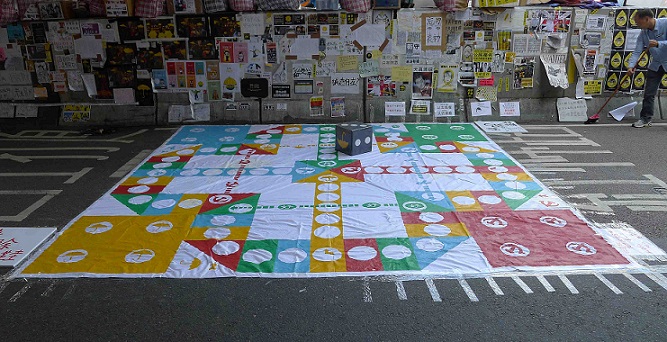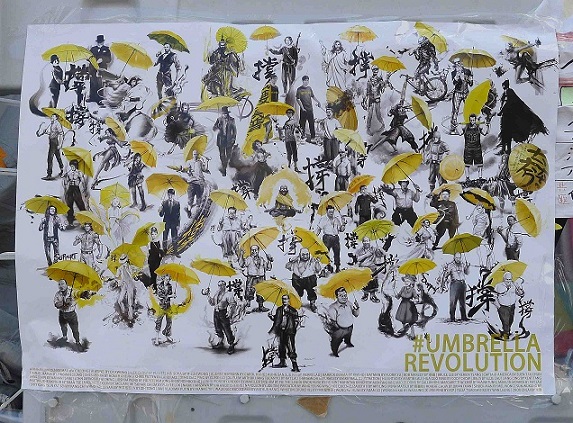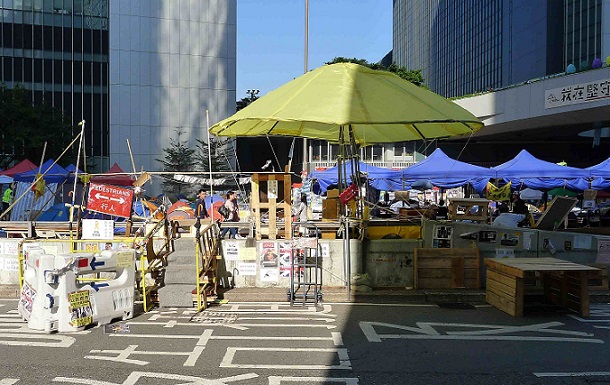藝術議題
- 傘運創意最新的專題文章如下。如欲閱讀有關同一議題的其他文章,可再點擊右下角資料庫的年份和月份。
Hong Kong’s fighting spirit
約翰百德 (John BATTEN)
at 11:27am on 27th November 2014




Captions:
1. Large-scale boardgame and dice, Admiralty, November 2014.
2. Designed poster by different artists & designers or different public figures & film characters holding umbrellas, Admiralty, November 2014.
3. Constructed large umbrella and stairway over road barrier, Admiralty, November 2014.
4. Assembled wind turbine generating 12volts of electricity, Admiralty, November 2014.
All photographs: John Batten.
(中文翻譯請往下看 Please scroll down to read the Chinese translation.)
As Hong Kong’s Umbrella Movement continues into its second month at the time of writing, the three main protest areas of Admiralty, Mongkok and Causeway Bay can offer inspiration to urban planners, designers, architects and the community as a whole.
What makes these three particular sites unique is that they have a particular ‘Hong Kong’ feel: a ‘make do’ and inventive construction approach to solving practical design problems with limited and at-hand material, similar to the vernacular architecture seen in Hong Kong’s street markets and previous squatter areas.
Likewise, the graphic representations seen in the thousands of posters and banners at the sites demonstrate great humour and satirical flair. What has been remarkable is how students have realised that their ability to reach out to a wider public relies on good organisation and being seen to be serious about their actions.
With many boycotting university classes, students gathered to hear alternative lectures and seminars at Tamar Park in late September; it was here that students first demonstrated their exceptional organisation skills. The park was rigged with a sound system, a stage was built and tents housed a range of activities. Most impressive was the ‘media area’, with students communicating on their computers about protest activities and issues relating to universal suffrage through a range of social and traditional media to the world.
Hong Kong’s professional politicians and government agencies could learn much from the way these students effectively use the internet, and translated lectures and other information into real-time English for the foreign press and readers from around the world.
Over the ensuing month, despite occasional hostility between members of the public at protest sites, the students organised a well functioning community to protest, study, live and discuss pro-democracy issues.
Importantly, the occupation of these places have been free of cars and traffic, creating quiet areas to walk, sit and talk — showing how easily and successfully Hong Kong can, should and must have an entirely new approach to urban planning.
A version of this article was originally published in Perspective, December 2014.
香港不言棄
運動佔領區看似和香港的街市和舊棚屋區風馬牛不相及,彼此的歷史不單相隔數十年,社會背景更是南轅北轍。然而,三者都同樣體現了一種獨特的變通精神,對實際的設計問題作出最佳的回應。
執筆之際,香港的雨傘運動已經踏入第二個月,其中金鐘、旺角及銅鑼灣三個主要佔領區,都為城市規劃師、設計師、建築師及不同社區帶來了源源不絕的靈感。
三個佔領區之所以如此與眾不同,全因它們都有獨特的「香港」味:一如香港街市或從前棚屋區內所建的地道建築,民眾以「窮則變,變則通」的創新建築手法,善用手上有限的資源,一一解決實際的設計問題。
與此同時,佔領區內成千上萬的海報和橫幅都展現了出色的幽默感,極盡諷刺的能事。最令人讚嘆的是,學生已經意會若他們要擴大受眾的層面,便必須有良好的組織,並展現出認真、負責的形象。
在九月尾,大專罷課已是如火如荼,學生都聚集在添馬公園,出席不同的講座和研討會;就在此時此刻,學生首次展示了出色的組織能力。公園不單加裝了音響系統,更設有講台及多個帳篷,以舉辦一連串活動。當中的「傳媒區」更是可圈可點,學生紛紛用社交平台和傳統媒體,與世界各地交流抗爭資訊及討論有關普選的話題,令人印象深刻。
香港的職業政客和政府機構都可從學生身上學會如何活用互聯網,並將講義及其他資訊即時翻譯為英語,予外國媒體和讀者使用。
此後的一個月,佔領區的民眾之間儘管偶有摩擦,卻無礙同學組織運作良好的社區,並在此抗爭、學習、生活和討論民主議題。
佔領區內沒有任何車子和交通亦是重要的因素,使區內能夠保持寧靜,方便民眾行走、坐下和談話,而這亦正好展示了香港能夠、理應亦必須採納全新的城市規劃方針,不費吹灰之力便可善用空間。
